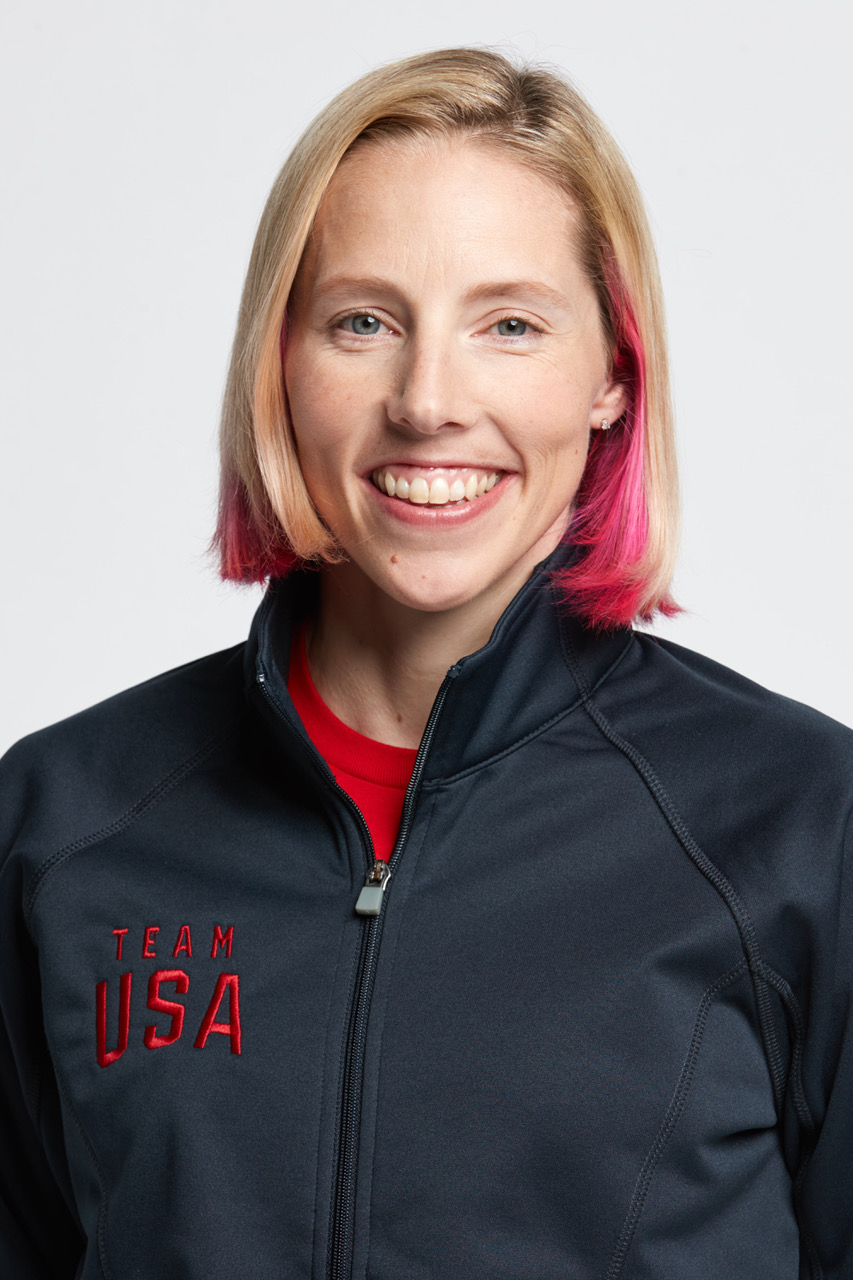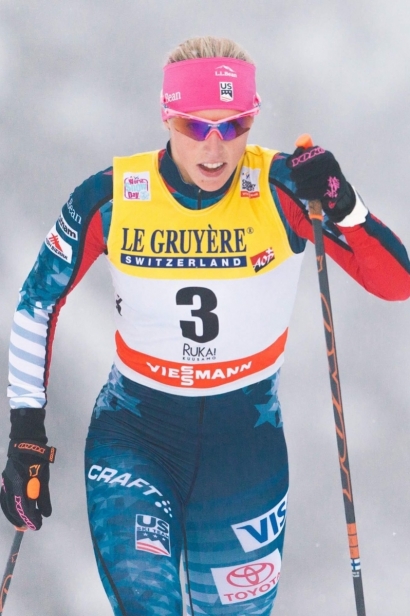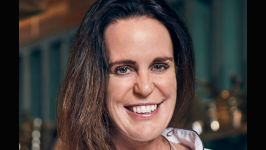DISH with Kikkan Randall
 The U.S. recently announced it has the largest Winter Olympics team of any nation in history with 242 athletes. Among those competitors is Kikkan Randall.
The U.S. recently announced it has the largest Winter Olympics team of any nation in history with 242 athletes. Among those competitors is Kikkan Randall.
In Europe, where for years she’s competed in a sport that’s as popular as baseball in America, her name has gravitas. Randall is the U.S.’s most-decorated cross-country skier. The games that open Feb. 9, 2018 in Pyeongchang, South Korea will be her fifth, which according to NBC is the most of any U.S. cross-country athlete. She has earned three World Championship medals, one in each color, and 33 World Cup podium finishes — 13 were gold.
She took time off from the sport to welcome her son Breck in 2016. Randall has written about how she balanced training as a new mom and has shared what it's been like taking the family on the road in pursuit of the Olympics with hopes of bringing home a medal.
Pyeongchang will be her last chance to do so. She’s retiring after this season.
I contacted her while she was in Austria in mid-January, about a week after she qualified for the 2018 Games. When we spoke, the local time was after 9 p.m. and she’d just put her son down for bed. But if she was tired, I couldn’t tell.
You recently qualified for your fifth Winter Olympics. How are you feeling?
Qualifying for the team, that’s always the first hurdle, and our women’s team is so strong right now that just making the team was no easy task. So I feel really good about being named to the team and now I can really focus all my preparation on being in my peak physical shape in about a month.
Have you been to South Korea before?
I have, ironically though it was in the summer. I went there for some meetings with the International Ski Federation — I was an athlete rep for eight years — so I attended some meetings there. I got to tour the venue in the summer with green grass, but I opted not to go there last winter when they did a test event, so I have not seen it in snow.
What are you most excited for about getting to go there as an Olympic athlete?
I’m excited to do an Olympics in Asia. I’ve gotten to do one in Europe, I’ve gotten to do two in North America. Sochi was kind of its own place, but I think Pyeongchang worked hard to get the Olympics there and they want to create kind of a winter culture all over Asia, so I think they’re really going to go all out. I’m looking forward to getting there and soaking up the Olympic atmosphere again, because it’s just something that’s hard to describe. We wait four years to do it. I get to enjoy that one more time. Also, just find my top shape of the season and be ready to race.
Do you spend most winters in Europe?
Yeah, I do. Every year we have a World Cup tour. It starts at the end of November and goes until the middle of March, and unfortunately Alaska being 10 time zones away, it’s a little hard to get back in between races because we are competing almost every weekend. So the American team, we pretty much pack up in early November and we spend four or five months on the road traveling to the races and then come home in April.
Do you notice that the time difference to these countries where you’re competing affects your performance or your eating habits?
I think over the years I’ve gotten better and better at adjusting to the time change. We do come over a couple of weeks before the first race so that we have time to adjust to the different time zone and get on the different eating schedule. But it’s become kind of second nature to me, I just hop over. In Korea in particular though, we do have some special strategies because we’re going to be competing mostly in the afternoon and evenings because of TV time back in Europe. So even though it will be about an eight-hour time change from where we are now, we’re planning to not really adjust. We’re going to stay up late and sleep late, and kind of try to keep our routine closer to the time where we’d be competing in the day in Europe to kind of make that feel the same in Korea.
That’s an interesting tactic. Have you done anything like that before?
Not quite to this extent. One time we had a world championships in Japan and we were doing an event in China just a few days before. Our flights got delayed and we got in to our hotel at like two in the morning and we had an early start the next day. We sort of got up and I remember the Chinese hotel we were staying at had a very interesting buffet — not exactly what we were used to eating for breakfast. So it was kind of like: arrive in the middle of the night, food you’re not sure of, race, and then right back over to Japan. Kind of a whirlwind 48 hours.
Do you have a favorite food memory from the Olympics?
I always remember when I walk into the dining hall. At first, it’s so overwhelming. They are catering to the world so they have cuisine for every major cultural group. So when you’re taking your tray for that first meal, you’re like, “Oh my gosh. Where do I even begin?” There’s so many different options. But of course we’re there for a couple of weeks so over the course of it, you try different things and then by the end you’re kind of like, “Wow, with all that choice, I’m just kind of sick of eating.” And I just want to go back to simplicity.
Do you get to go out to eat and explore the towns where you are or is everything you eat from that cafeteria?
It’ll probably be a little bit of both. We’ll be staying in the main athlete village, so it will be a huge — I can’t remember if it’s a permanent structure or a tent — but it’s going to be a huge dining area because a lot of the sports are staying in that village. So we’ll have options to eat there 24 hours a day. The U.S. Olympic Committee is actually setting up its own off-site restaurant because one of the concerns is when you have that many athletes eating in one place and sickness gets introduced, it can run rampant. So in order to try to keep everybody as healthy as possible, they’d like the U.S. athletes to be slightly off to their own. We’re going to have an option to take a short shuttle ride over to a USOC house and get some of our meals there. For practicality, we’ll probably do our lunches and dinners at the USOC, but breakfast we’ll either do in the dining rooms or we’ll prepare it in our rooms with hot plates. A few things we could make, simple breakfast foods, right in our rooms.
Do most people do that? Bringing a hot plate and their own food?
Every team and every country has their own strategy. In Sochi, I know a lot of athletes were using the main dining hall and overall it went pretty well. But I’m sure every country is stocking their dorms with supplies so that athletes have all the snacks and food they need through the games. The Olympics is such a bigger event. There’s so much media there and security checks that everything takes a little bit longer, so you actually burn through more energy than you realize, beyond the training you’re doing. It’s nice to have access to food and water everywhere you go.
I read multiple places online that your favorite food is Canadian bacon and pineapple pizza. What makes that your favorite?
It’s one of those easy go-to things that’s pretty similar wherever you go. So it’s definitely something I will never say no to. (laughs) I like the combination of the salty ham and the pineapple. I’ve always found it an intriguing combination. I also, over the years that I’ve been coming foreign places, love finding food in each place to look forward to. You don’t find Canadian bacon and pineapple pizza over here too much, so it’s one of those things I like to enjoy while I’m home and when I’m [in Europe] I have other things I look forward to.
You’re married to Jeff Ellis, a former ski racer for Canada. The two of you became parents in 2016. How has having your son Breck changed both of your training and eating schedules?
That’s a very good question. Being an athlete for so long, I got to be so focused on myself and what I needed to perform. Thankfully, Jeff is very supportive of that and was an athlete himself full-time for a long time as well. When we had Breck, it was a total shift. Now, we weren’t on our schedule anymore. We were on Breck’s schedule. We’ve adapted pretty well I think, but with the eating I’ve noticed that I’m pretty focused on getting Breck what he needs first and I fill my needs afterwards. For me personally, I have to focus on my nutrition as well, so I really have to rely on Jeff and my parents to help out and help take care of Breck so I can get access to the nutrition I need or the recovery I need. But it’s also been really fun. I look at food through a little bit of a different lens. Not just in terms of what I need to perform, but also the healthy habits that I’d like to pass along to my son. I enjoy food and I want him to enjoy food, too. It’s kind of fun to have it be a whole family experience.
"Growing up in Alaska, I got the opportunity to be spoiled in a sense and get to have a lot of really fresh wild seafood and I think that’s part of what’s made me such a successful athlete and have a healthy lifestyle."
Do you have a training diet separate from what we’d call a typical healthy diet?
No, that’s one of the great things about cross-country skiing, I think. It’s really just a healthy lifestyle and everything you do to be a healthy person helps you be a faster skier. It’s a balance of getting the right amount of energy in and the right amount of ingredients at the right time of day. I get to eat a lot because I burn a lot of calories. Breakfast is one of my favorite meals, so I load up on omelettes quite often. Jeff is quite the chef, so he makes up a great omelette in the morning and we all enjoy that together. Then throughout the rest of the day it’s a lot of snacks. Trying to get in good quality protein sources and carbs. You have a lot of flexibility and freedom in there. As long as you have the main ingredients, you can kind of tailor it to individual tastes. Overall, I think my strategy has been to try give myself the best fuel I can to maintain a good body composition, a good healthy immune system, and strength to rebuild my body as I break it down in training. But also, enjoying it and feeling normal so that I can sustain my career over 20 years.
You previously were a spokesperson for Alaska seafood and for healthy eating. Why was that important for you?
Growing up in Alaska, I got the opportunity to be spoiled in a sense and get to have a lot of really fresh wild seafood and I think that’s part of what’s made me such a successful athlete and have a healthy lifestyle. When I got approached with the opportunity to go out and promote that message and help others either discover Alaska seafood for the first time or encourage them to add more to their diet as a way to live a healthy lifestyle, it fit in perfectly with what I do as an athlete and what I really care about. It’s always been a passion of mine.
I feel like there are two kinds of people in the world: those who live to eat and those who eat to live. Which do you think you are?
I think I live to eat. A big part of who I am is the physical activity piece, and I of course do that and enjoy it, but also use that as a way to say, “OK, now I can go out and enjoy food more because I worked for it.” And that relationship helps me maintain a good, healthy body composition, but also my enjoyment of food in general. When I work hard and give myself something that is a reward after a workout, it always tastes better when I’ve earned it as opposed to going and picking it up anytime.
For example, one of my favorite things is actually the maple-glazed doughnuts at Carr’s. So many a workout, I’ve used that as an incentive for myself to go longer and push a little harder, and as my reward I can go grab one on the way home. One time I was walking into Carr’s Huffman [ in Anchorage ] and I was about to pull one out of the case and a little girl came up to me and said, “[gasp] Kikkan Randall eats doughnuts!” (laughs) I felt like I was caught red-handed, but at the same time I was like, “Yeah, well I just finished a three-hour run so I earned this.”
I normally ask if people if they have a guilty pleasure comfort food, but I like that you say they’re reward foods instead.
Yep, yep, reward foods. I try to make sure I earn those. (laughs)
What’s in your fridge right now?
We just arrived at a new place. We’re in Seefeld, Austria. So we actually just went to the grocery store and got our basics. We’ve got our milk, eggs, bread, some salad mix, bananas, oranges. Just had some chicken and pasta for dinner. Nothing too crazy, but some good staple ingredients to make a lot of good stuff.
Do you cook a lot when you’re on the road?
In previous years, we haven’t so much because these European hotels have family-run restaurants as part of the whole stay package. So for many of the years that I’ve been over here, we’ve had three prepared meals a day and supplementing our own snacks in between. But now that I have the family on the road with me, with Breck we’ve found it’s nicer to cook and be on our own schedule. For the last month, we were in Switzerland and we’d rented an apartment and were cooking on our own. And now we’re here in Austria for two and a half weeks where we’ll be cooking on our own.
I read that you also are a founder and lead U.S. Ambassador for Fast and Female? Can you tell me a little bit about it and your work with them?
Yeah, it’s a really fun project to be working with. It was started by a really good friend of mine who is an Olympic gold medalist in Canada. She started it small and quietly in 2005. We became really good friends around 2006-2007 because she was the only Canadian woman on the World Cup and I was the only American on the World Cup. Not having our own teammates, we kind of bonded together. When she told me about Fast and Female and how it was designed to inspire girls to stay in sports for life — because girls are much more likely to drop out — I fell in love with the concept because I personally have experienced so many benefits from being in sports. I saw that there were these barriers that we could address to keep girls involved in it.
They don’t have to necessarily be competitive athletes. We just want them to stay involved, be healthy, be active, do it together, and give them access to good role models. So, I kind of started leading the charge in the U.S. and got some events in Anchorage when we had the first nationals there in 2009-2010. Since then, we’ve expanded in the U.S. to do about 10 events a year in different parts of the country.
I’ve been doing what I can to support the program while I’ve been competing, but to be a full-time athlete and a mom and run an organization is … at times I’ve had my plate a little too full. This is going to be my last racing season and when I’m done, I’m really excited to focus a lot more energy on Fast and Female.
You can cheer on Kikkan Randall and her teammates representing the U.S. when the Olympics start Feb. 9, 2018.
Jessica Stugelmayer is the senior digital content editor for Edible Alaska. She can be reached via email, Facebook, Twitter, and Instagram.
Some questions in this interview have been edited for clarity.








